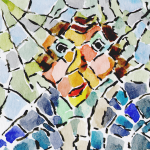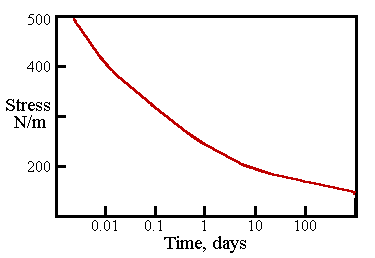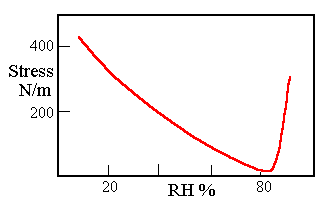
 |
Stress, strain and craquelure - 8 |
If oil paint, or glue or canvas is stressed, by change of humidity or temperature, towards the top end of its stress-strain curve and then left alone, the stress will decline, fast at first, then at a diminishing rate. This is known as stress-relaxation and is the reason why we have any old oil paintings at all. Stress-relaxation is not, however, entirely beneficial. It is also the cause of slack canvases that allow stretching and shrinking of the paint layer, with consequent flaking.
 Canvas simply cannot sustain the tension created at the moment of stretching over the wooden frame. Michalski and Hartin have studied this phenomenon (1). The diagram is derived from their work on a strip from a model oil painting. This relaxation from the initial stress is the reason why paintings have their stretchers periodically enlarged by banging wedges into the corners. Stress builds up in the corners as a result, causing the characteristic craquelure described in part 2.
Canvas simply cannot sustain the tension created at the moment of stretching over the wooden frame. Michalski and Hartin have studied this phenomenon (1). The diagram is derived from their work on a strip from a model oil painting. This relaxation from the initial stress is the reason why paintings have their stretchers periodically enlarged by banging wedges into the corners. Stress builds up in the corners as a result, causing the characteristic craquelure described in part 2.
Notice that the stress falls away more slowly as it declines. It seems therefore that the most important measure to protect paintings from premature wrinkles in the canvas is to prevent all environmental changes that cause high stress, or alternatively design painting supports that yield to the stress so that it never gets high.
 The environmental causes of high stress that have been identified so far are shrinking of the paint and ground with low temperature and shrinkage caused by low RH acting mainly on the glue size. The canvas has not so far seemed to be much of a player in this drama. This is not quite correct. Canvas, particularly modern machine made canvas, has one bad habit: it shrinks powerfully at high relative humidity. Hedley (2) has demonstrated this effect by holding canvas strips at a constant 0.3% strain and then changing the relative humidity. The diagram shows the dramatic rise in stress over about 80% RH
The environmental causes of high stress that have been identified so far are shrinking of the paint and ground with low temperature and shrinkage caused by low RH acting mainly on the glue size. The canvas has not so far seemed to be much of a player in this drama. This is not quite correct. Canvas, particularly modern machine made canvas, has one bad habit: it shrinks powerfully at high relative humidity. Hedley (2) has demonstrated this effect by holding canvas strips at a constant 0.3% strain and then changing the relative humidity. The diagram shows the dramatic rise in stress over about 80% RH

Sumo wrestlers, before and after re-sizing treatment
The powerful increase in stress at high RH is caused by the sideways swelling of the yarn fibres. The fatter yarns then have a longer path around each other, like hugging Sumo wrestlers, which results in a shortening of the cloth, or an increase in stress if the cloth is restrained. The effect is even more dramatic if the canvas is restrained in both directions (I leave the reader to sketch the Sumo version of this situation).
If the climate cannot be controlled to a constant, moderate RH and T, the next best way of preventing excess stress, which will first crack the paint and then lead to slackness in the canvas, is to allow the canvas to change size to accommodate the stress peaks. It is not a good idea to allow the painting to change shape freely without restraint, because this gives free play to the competing tendencies of the various layers of the painting. It seems best to apply a moderate and constant stress.
Gustav Berger comments on the good condition of the gigantic dioramas which travelled around the USA in the last century, These pictures were frequently rolled up for transport, between being exhibited hanging from a hoop. The bottom was held in tension by another hoop, loaded with weights. The bottom was therefore free to rise and fall with the changing climate. The horizontal stresses were relieved by shrinkage in the middle of the canvas, giving a variable waist line.
1. Michalski, S and Hartin, D.Daly, CCI lining project: Preliminary testing of lined model paintings, ICOM-CC, Preprints of the Edinburgh conference, 1996, 288-296
2. Hedley, G., Relative humidity and the stress/strain response of canvas paintings: uniaxial measurements of naturally aged samples, Studies in Conservation 33 (1988) 133-148.

This work is licensed under a Creative Commons Attribution-Noncommercial-No Derivative Works 3.0 License.